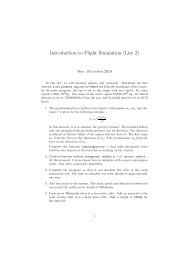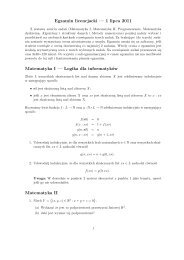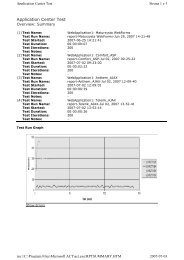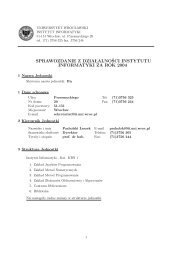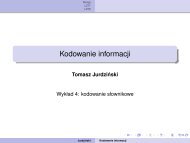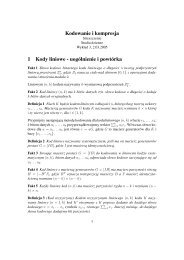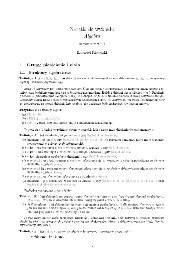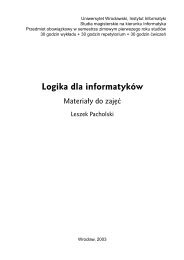Programming 2012
Programming 2012
Programming 2012
You also want an ePaper? Increase the reach of your titles
YUMPU automatically turns print PDFs into web optimized ePapers that Google loves.
<strong>Programming</strong> <strong>2012</strong><br />
Laboratory session no. 2<br />
Problem 1 (1p)<br />
Ask Prolog the following queries:<br />
• Does X unify with list [1,2,3,4];<br />
• Does X unify with list whose head is 1;<br />
• Does X unify with list whose first two elements are 1 and 2;<br />
• Does X unify with a singleton list? Singleton list is a list of length 1;<br />
• Does X unify with a list of length 3?<br />
Problem 2 (1p)<br />
Define in Prolog the predicates listed below:<br />
• first(X) satisfied when X unifies with list [1,2,3,4];<br />
• second(X) satisfied when X unifies with list whose head is 1;<br />
• third(X) satisfied when X unifies with list whose first two elements are<br />
1 and 2;<br />
• fourth(X) satisfied when X unifies with a singleton list. Singleton list<br />
is a list of length 1;<br />
• fifth(X) satisfied when X unifies with a list of length 3?<br />
Problem 3 (1p)<br />
Define in Prolog predicate even/2 such that even(N) is satisfied when N is<br />
an even number. Provide two implementations of the predicate. First using<br />
modulo division and second – recursion.<br />
Problem 4 (3p)<br />
We represent binary trees with labelled internal nodes in Prolog using the<br />
functor node/3 for internal nodes and the atom leaf/0 for leaves. E.g., the<br />
structure:<br />
represents the tree:<br />
node(leaf, 3, node(leaf, 5, leaf))<br />
3<br />
5<br />
1
Define predicates mirror/2, which creates the mirror image of a tree and<br />
flatten/2, which creates a list of the tree labels in the infix order.<br />
2



